Blog Blog Day 1 – June 25, 2018 Blog Day 2 – June 26, 2018 Blog Day 3 – June 27, 2018 Blog Day 4 – June 28, 2018 Blog Day 5 – June 29, 2018 Blog Day 6 – June 30, 2018 Blog Day 7 – July 1, 2018 Blog Day 8 – July 2, Read More ...

ICRPS 2018 Summer Institute | Tuskegee, AL | June 24-July 07
"Social Justice, Rural and Natural Resource Policy"
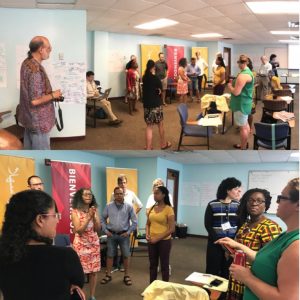 Today was the last day for lectures and we finished with a bang. The morning lectures included topics of migration and the causes of migration as well as how it relates to remittances. We broke into pairs and discussed our personal migrations along with the reasoning of the moves. Universally family, education, and opportunity guided our reasons for migration. We ended the morning session learning about Alabama ASPIRE. This organization focuses their time, energy and resources to influence legislators votes on policies that would improve the quality of life for rural Alabama families. These policies range from increasing income tax requirements to eliminating taxes on food.
Today was the last day for lectures and we finished with a bang. The morning lectures included topics of migration and the causes of migration as well as how it relates to remittances. We broke into pairs and discussed our personal migrations along with the reasoning of the moves. Universally family, education, and opportunity guided our reasons for migration. We ended the morning session learning about Alabama ASPIRE. This organization focuses their time, energy and resources to influence legislators votes on policies that would improve the quality of life for rural Alabama families. These policies range from increasing income tax requirements to eliminating taxes on food.
After Lunch, our day continued with a session on feeding the world, a social justices approach. We were introduced to social Justice perspective in the food supply chain and we discussed the Oligopolistic links and how it creates unbalanced negotiation power among actors. We learned that to counterbalance the concentration of power, there is need for the creation of farm producers’ organization and niche markets. This will the farm producers to negotiate directly with consumer and thus increase negotiation power. In addition, we discussed how heterosis effect can be used to improve production. To help reduces challenges, food supply chain needs to be managed by government and at the same time the food supply should be enshrined into a territory so as to foster security at the local level.
Next, we discussed Biotechnology to feed the world!!!! We considered the shift of Paradigm from antiquity to agriculture revolution. The next big thing now is Genome editing as well as Big data and precision Agriculture which utilize technology advancement which constitute a quicker way to make changes.
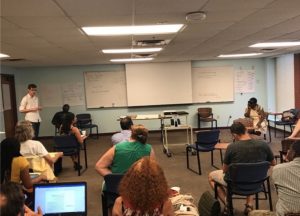 The last lecture of the day focused on organic production and small-scale farming. We learned that there is an obvious gap between conventional and organic farming. Generally, more research opportunities and incentives are available to conventional farmers. Another important point is the higher labor needed for organic farming versus conventional farming which explains why organic food products are more expensive. However, we were reminded that it is a choice to either choose between organic or non-organic food products, so, if you want to change what you put inside change what you are eat.
The last lecture of the day focused on organic production and small-scale farming. We learned that there is an obvious gap between conventional and organic farming. Generally, more research opportunities and incentives are available to conventional farmers. Another important point is the higher labor needed for organic farming versus conventional farming which explains why organic food products are more expensive. However, we were reminded that it is a choice to either choose between organic or non-organic food products, so, if you want to change what you put inside change what you are eat.
After, we broke out into groups to discuss our final Presentation. The break-out session lasted for about 3 hours. It was great to see student gather together to prepare for their final presentations. Safe to say that we are ready to address to disparity issues.
Written by: Palash Ranjan Sanyal & Stephen Penner
 Starter
Starter
It’s a perfect 4th of July, 85 F outside and the group is ready to hit the road. We will head out in few minutes as everyone gathers for breakfast. This is a group craving for good coffee, every morning. Today’s choice is Coffee from burger king and burger king only.
Good to have coffee
People had their coffee, and now making connection continues. Stephen sitting next to me is in a deep discussion on poverty and investment. Ryan and Kara, Micheal and Shireen, Lidia and Philomina, the micro conversations continues.
Out of Bus
We reached the Callaway Resort in 2 hours and right away went for activities. Some went swimming, some played basketball and some went for a hike.
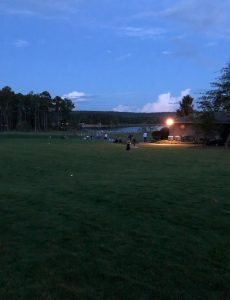
4th from the perspective of visitors
Oh say can you see,
We got a glimpse of the great American melting pot! All colours, shapes, and socio-economic classes.
What so proudly we hail’d,
America communing together to celebrate American independence
We witnessed – The rockets red glare and the bombs bursting in air (fireworks), the gallant streams (in all the activities) and saw that no other country waves the flag like America.
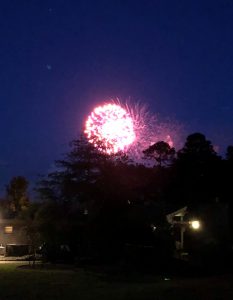
Written by: Dinesh Dhakal & Merlin Hernandez
We started Day 9 by reviewing what we learned in our last visit of Dekalb County Farmers Market and The Jimmy Carter Presidential Library and Museum. Everybody shared how those two sites are connected to social justice and rural policy. The products available in the farmers market are diverse, fresh and even live. We all believed that farmers are getting market access and fair prices for their products. It was insightful to discover that Jimmy Carter is nurtured by an African American community. This undoubtedly influenced Carter’s approach to social justice and rural policy programs that sought to benefit the poorest sectors of the society. The Carter commitment to human rights and his accomplishments in international peace are some of the exemplary aspects of his presidency.
The sessions were dedicated to policies and programs for indigenous and minority farmers, land owners and communities. Tuskegee Graduate, Miles Robinson who spearheads the USDA Outreach and Assistance for Socially Disadvantaged Farmers and Ranchers, brought a clear grassroots focus to the session in outlining farmer engagement in the process of rural development as an important challenge for African American farmers in the Black Belt South. There is a long history of mistrust of government bureaucracies. Farmers often select themselves out of available programs because they do not believe that they would qualify, do not know about programs or how to access them. Miles’s role is one of outreach and advocacy, and he sits with farmers and their families in the process of building a trust relationship. This allows Miles and his team to provide assistance with farm ownership, loan applications, financial management, technical assistance, and the purchase of operating equipment. There has been some success in creating long-term relationships with retail chains like Walmart.
Philomena De Lima of the University of the Highlands in Scotland sought some clarity on the implications of the link between rural small producers, who are happy to have a ready market for all they can produce, and large food chains who may offer lower prices, and demand costly production improvements and increased capacity. This lowers farmers’ margins and they are forced to reduce costs by lowering wages. Perhaps the most far-reaching casualty of such relationships is that of small farmers outside of the system who cannot price-compete. Philomena saw the issue as one of social justice.
Sara Epp of the Universityof Guelph, Canada used teleconferencing to interact with the delegates to explore The Migration of Mennonite Farmers in Canada from Southern Ontario to the North. There are similarities in the experiences of Southern Black Belt farmers and the Mennonites in terms of high costs of operations and the need for diversified revenue streams. Labor costs are lower for the Canadian groups because of the social and family structures of Mennonite communities. Divergent marketing opportunities, however, see the Mennonite group capturing the markets in the remote communities of Northern Ontario while the farmers of the Black Belt face varying levels of competition.
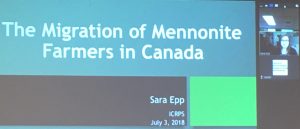
Another Tuskegee graduate, Amadu Diop, Outreach Liaison, USDA Forest Service examined Forestry and Underserved, Socially-Disadvantaged Minority Landowners as well as African American Land-Retention across 13 southern states. For African American landowners, forestry is one of the most important assets that can provide diverse sources of income. There are however, many reasons why forestry fails to provide significant incomes to this community. Those reasons are under-participation in forest management training, decline in African American farm ownership, heir property issues and documentation for inherited lands. Amadu is involved in education, building social networks, legal assistance, and building capacity through linkages with technical and financial assistance.
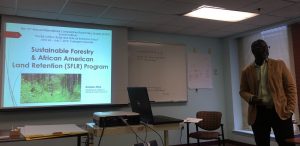
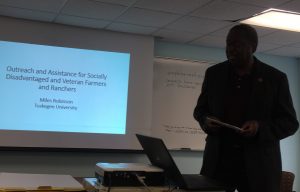
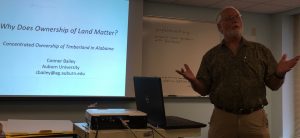

After lunch, participants learned about Natural resources and the environment focusing on minority populations. Conner Bailey, of Auburn University, presented on issues timberland ownership inequality in Alabama State, and how unequal distribution of timberland affects the livelihood of minority population. It is fascinating to know that property tax is lowest in Alabama State among the 50 states of the USA. It would be logical to raise the property tax revenue that can be spent on minority population through the education and health sectors. Souleyman Fall from Tuskegee University highlighted the use of the GIS tool, and how it works as a powerful instrument to create new data in order to do Environmental Justice (EJ) analyses focusing on minority populations. Joseph Quansah, Tuskegee University, discussed the real climate changes in Alabama State and its effects on minority populations. Joseph further outlined potential climate change adaptation strategies in order to mitigate impact on vulnerable communities. Finally, Raymon Shange, Tuskegee University discussed small land owners and rural community outreach program of the Tuskegee University that focuses on food, agriculture and the environment.
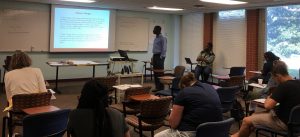
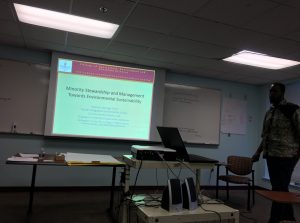
Finally ICRPS finished the afternoon session entitled Climate Change and Environmental Justice with Marco Pagani, University of Bologna who began his presentation with how bioenergy could be used as a means for rural development. Gabino Nava-Bernal, Universidad del Estado de Mexico, explored climate change strategies to deal with climate variability based on field reality and farmers perceptions. Climate change adaptive new cultivars, understanding climate change through time, crop calendar, and crop diversification are some of the important strategies to combat the effects of climate change. The afternoon session ended with the contribution of Catherine Flowers who works as Rural Development Manager for the Equal Justice Initiative. Catherine mentions the problem of inequality in rural social justice in the US. Furthermore, rural development and environmental justice is exacerbated by climate change. Catherine uses the example of Lowndes county and living conditions which are not normally seen in the developed countries. There is the presence of tropical parasites, with deficiencies in health care which are profound social justice issues.
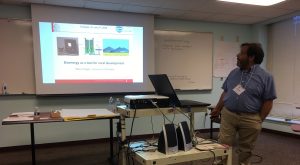
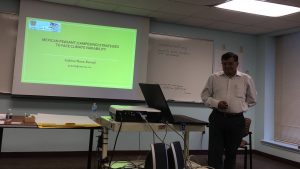
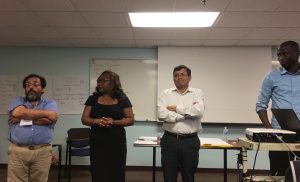
Written by: Ana Paola Balcazar Quinones &Gilbert Adjoyi
Day seven is student’s free day and students were free to do whatever they wanted while the faculty had a meeting and dinner. Some of the students arranged and visited Shady Grove Road Blueberry Farm to help to the owner Mrs. Josie Gbadamosi, a retired nurse, who migrated to Tuskegee, Alabama from Los Angeles, California and purchased the 46-acre land in June 2010. Josie restored two and a half acres of the 20-year-old blueberry bushes armed with hoes, chain saws and with the help of family, friends, community volunteers, Tuskegee University staff and students, and an occasional paid laborer. She markets her products through pick/pay, pick/share, direct sales, wholesale to two local grocery stores, and sales at the farmer’s market. She briefed the students on the history, joy and progress of her work.
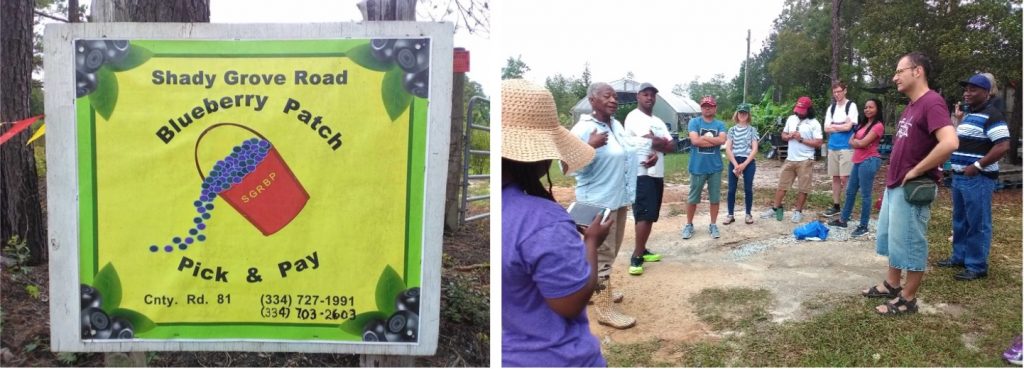
Armed with a bucket each, the students picked about 40 lbs. of produce and enough for every everyone to take home for their personal consumption. The students are planning to use part of the blue berries to make pies or crumble, using local ingredients from the farmers’ market on Wednesday and probably use the Tuskegee University Post Harvest Center kitchen to make pies or crumble. This can be a nice cooking experience for the Disparity in Food presentation.
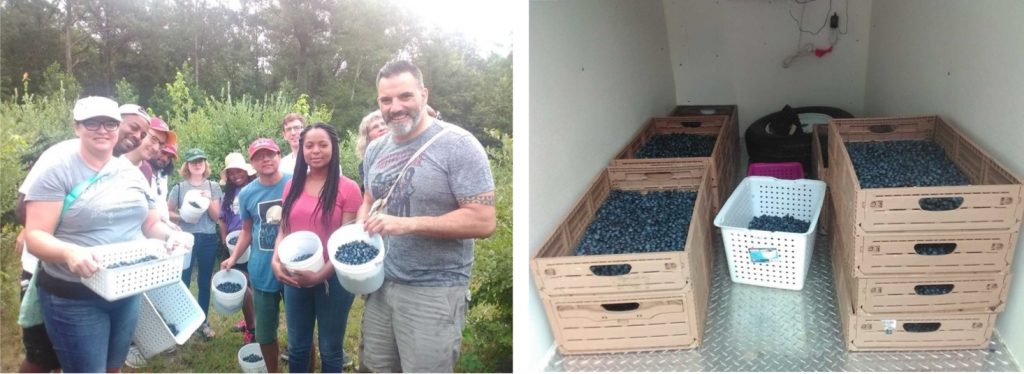
The students were also led to learn about the other plants and crops Mrs Gbadamosi have on her land, such as Moringa, Mint plant, blackberry and sunflower. Every student departed the farm happy and well informed about Shady Grove Road Farm’s role in fostering community development, togetherness and teaching students to give a helping hand when the community needs it.
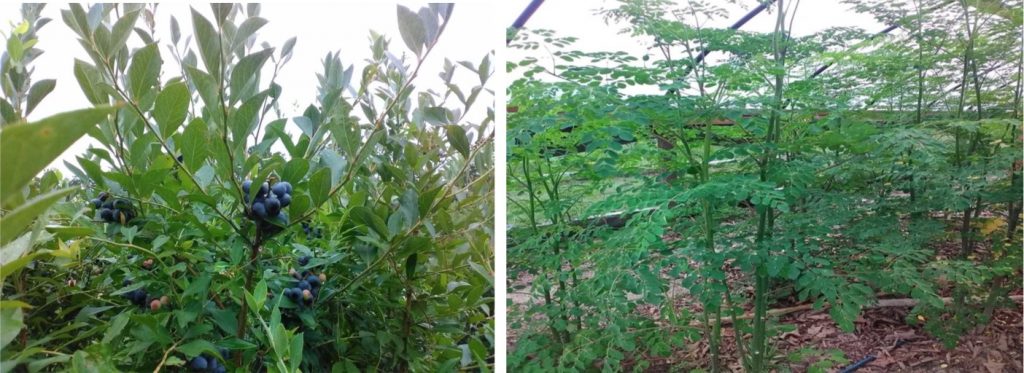
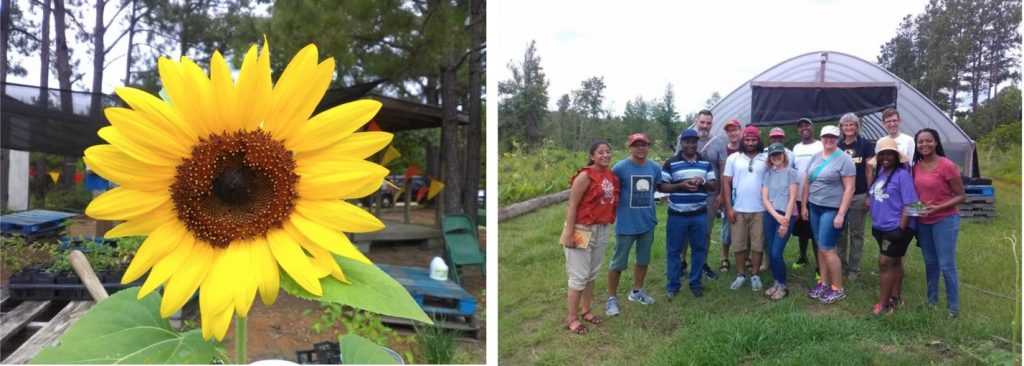
Day activities for the afternoon section of the day were two-fold. After lunch meal, some faculty went to visit the Tuskegee University Chapel and others went to rest. Some students worked on their group presentations while other students went to rest. Some did their laundries, and some went to visit the Lake Martin. Those who visited the lake, arrived at Paces trail side of it, located in Dadeville city. Lake Martin is about 30 minutes-drive from Tuskegee University, and is the largest man-made lake in the USA. It is 31 miles long and is about 170 feet deep. The photos below provide a few information about the lake and the visit.
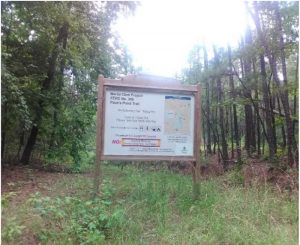
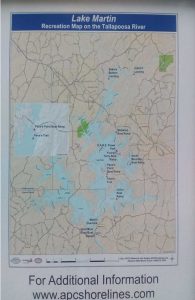
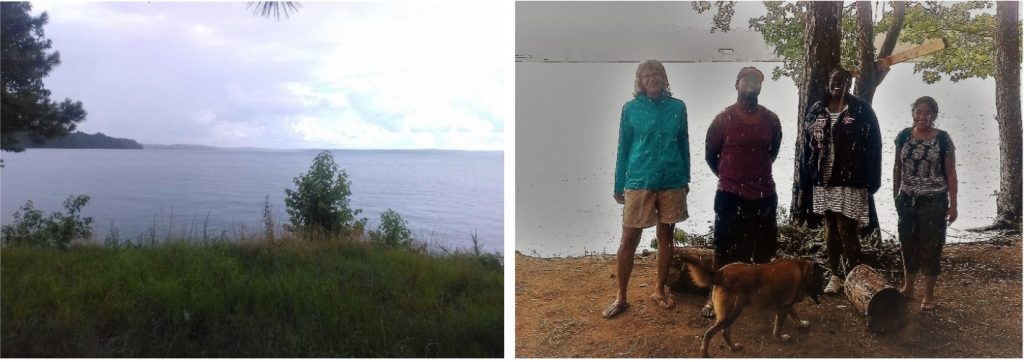
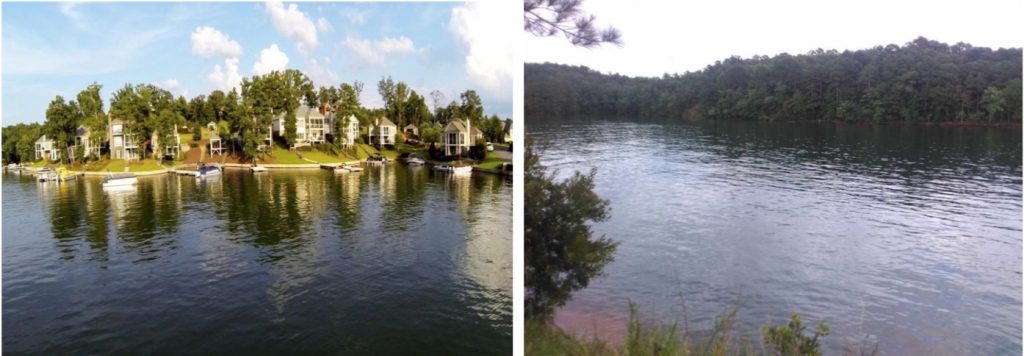
The students who visited Lake Martin also visited the Tuskegee Airforce Air Field.
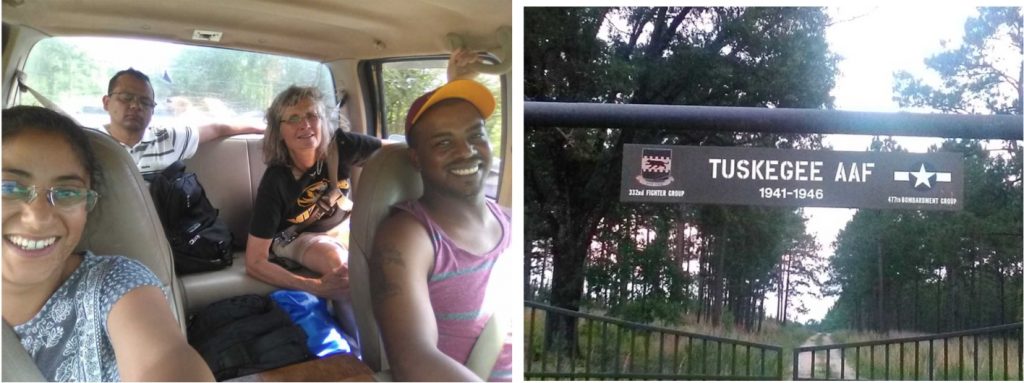
In all, the student free day had been a very exciting and successful day when students relaxed and enjoyed themselves.
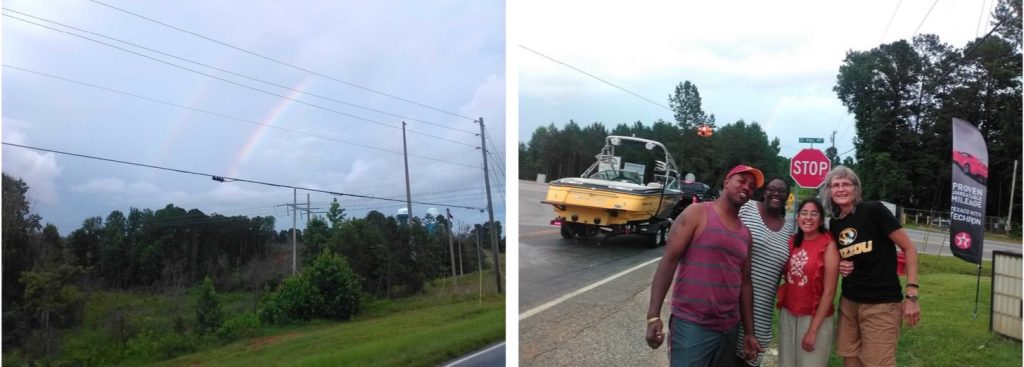
Written by: Lindsey Lunsford and Stephen Penner
Reflecting on our journey from Tuskegee to Atlanta, the dominant narrative of the rural to urban divide weighed heavy. People and place-based concepts would weigh heavy on the group. Coming in from the rural- Tuskegee population of 8,722 with a density of 532/mi² compared to Atlanta at a population of 472,522 with a density of 3, 526/mi² served as a strange contrast. The ICRPS group was doing this once, many of the Tuskegee students do this repeatedly with frequent sojourns to the bigger cities of Montgomery, Atlanta, and Birmingham- this juxtaposition and contrast is harsh.
From calm to hurried, airy to dense, communalism to a sense of individualism- lost in the numbers- it was a deep contrast. We started our “big city trip” at the wickedly diverse “Your Dekalb County Farmers Market” http://www.dekalbfarmersmarket.com- where the veil of Atlanta disappeared into a swirl of food cultures. Five types of yams, durian, varieties of apples numbering in the teens, fish from across the globe and a goat stew that the late arrivals were able to have with the most delicious goat meat ( sorry early comers). It had the elements of a global place where acculturation conversation was ongoing in the form of food. Food shared among those wishing to remember a taste of home and food consumed by those wishing to explore other “places” through food.
Our post-activity lunch featured a tour of the Jimmy Carter Presidential Library and Museum. There was an abundance of evidence that spoke to President Carter’s commitment to Social Justice, be it in his early work in the de-segregating institutions in his home town of Plains, Georgia, to his work in post presidential life with the Carter Center https://www.cartercenter.org and Habitat for Humanity https://www.habitat.org . Carter built bridges among and between different global communities- both people and place based.
Our visit to Hotlanta concluded with a tour of the home of “fake news”, the CNN World Headquarters, (an acknowledgment and a wink to the ongoing national conversation) to see the inner workings of a global media giant. The tour showed us the number of people and the complexity of being one of the worlds’ “most watched network.”
We rounded the day out with brews and great conversation over dinner. Which sparked this post’s authors to add original poetry to this post! Below is an original poem written by Lindsey Lunsford upon the suggestion of her co-author, Stephen Penner. It’s written to describe the experience of rural people venturing to the big city. Enjoy 😉
“Where we come from….”
We are the small ones
The unreported
We come from the small places
The edges
The periphery
The outside
We speak from beyond the margins
We are here
We exist, and we belong in this space
This is our world as it yours
Us country folk?
No, We are not all white
No, We are not all polite
And the rural has not now nor ever been excused from blight
No, we are not out of sight
Let those with eyes… see us
Let those with ears… hear us
We produce the worlds food yet still we hunger
We give way to the green, the good, and the holy
Yet still our rivers bleed and our children continue to need
We dwell in the lands that your people came from
Before they danced in to the expanse known as urban
Before the reflection of the setting sun on sky scraper glass blinded them to the lands of their origin
We do not suffer in silence
Gunshots still signal the violence
And we take cover as our climate rises
We come from the small places
The edges
The periphery
The bush
The tundra
The woods
The back of beyond
The hinterland
The backcountry
The sticks
The middle of nowhere
The boondocks
You cannot forget us
We cannot be erased
No matter the speed of the developers or hesitation of the planners
We are not to be outcomes, out zoned, or outcast
Nor do we thrive in the sense nostalgia in which your sanity so heavily depends
We are not simply a vacation for those over run with city lights and siren wails
We are not the end of lovely tales of childhood and visits to grandma’s house
We are not a simple people
For we are the foundation of our civilization’s structure
The back roads are where you’ll find the backbones
We are live, living, and thriving just beyond the limits of humanity’s focus
We are our only hope
We speak from beyond the margins
And we are here
Poem by: Lindsey Lunsford
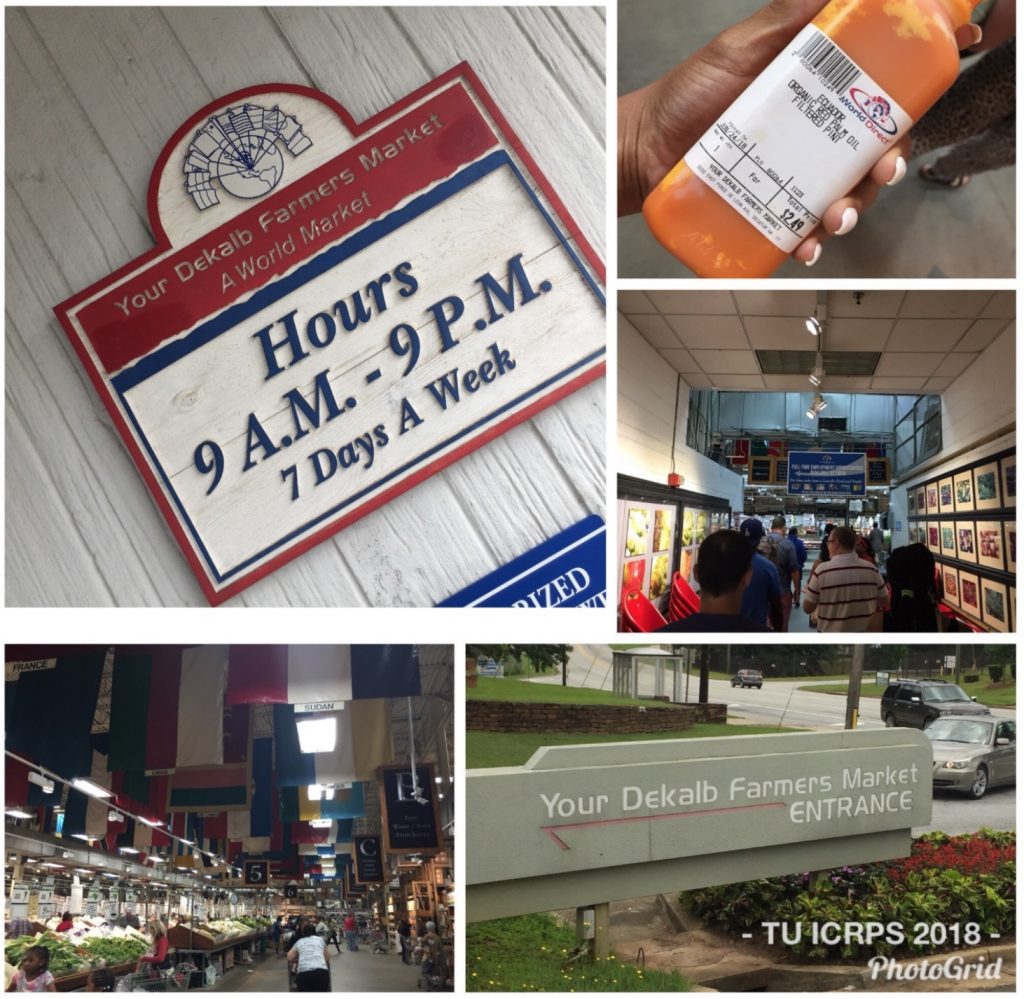
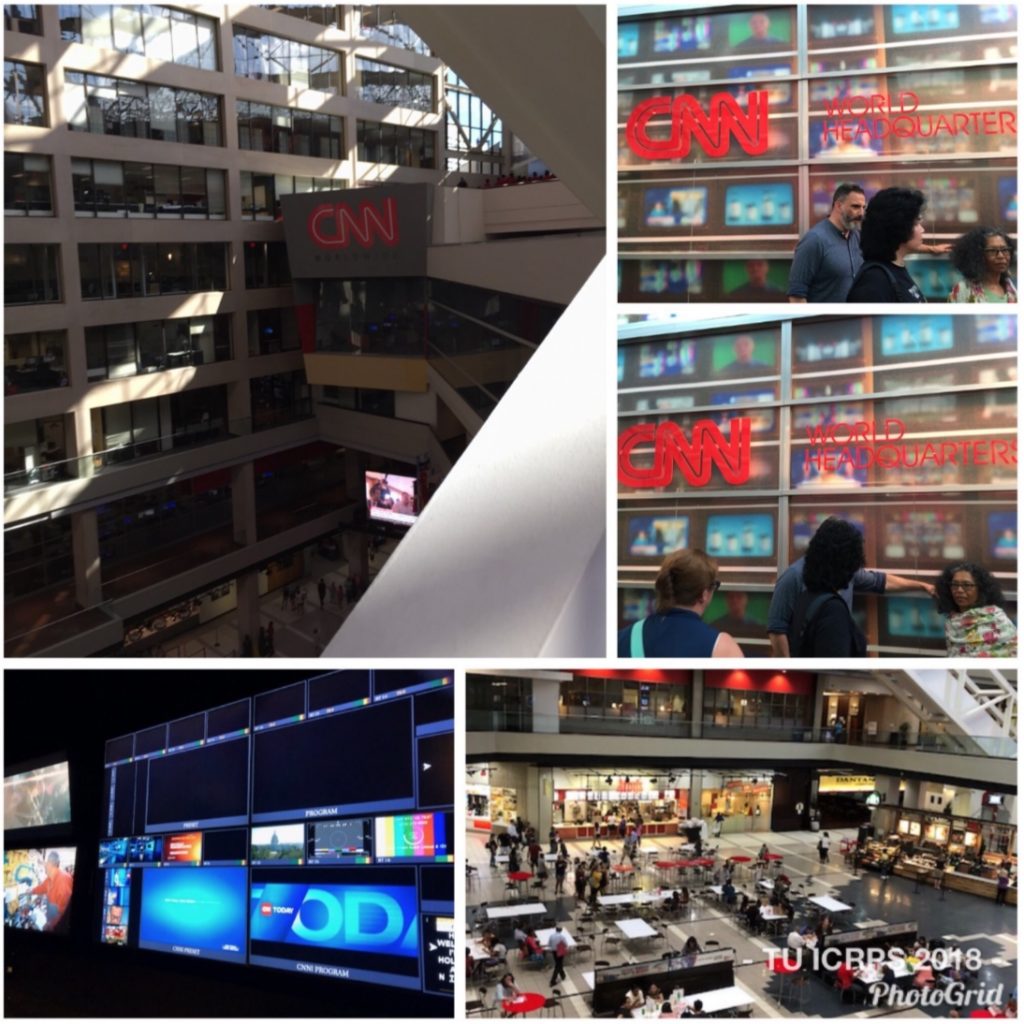
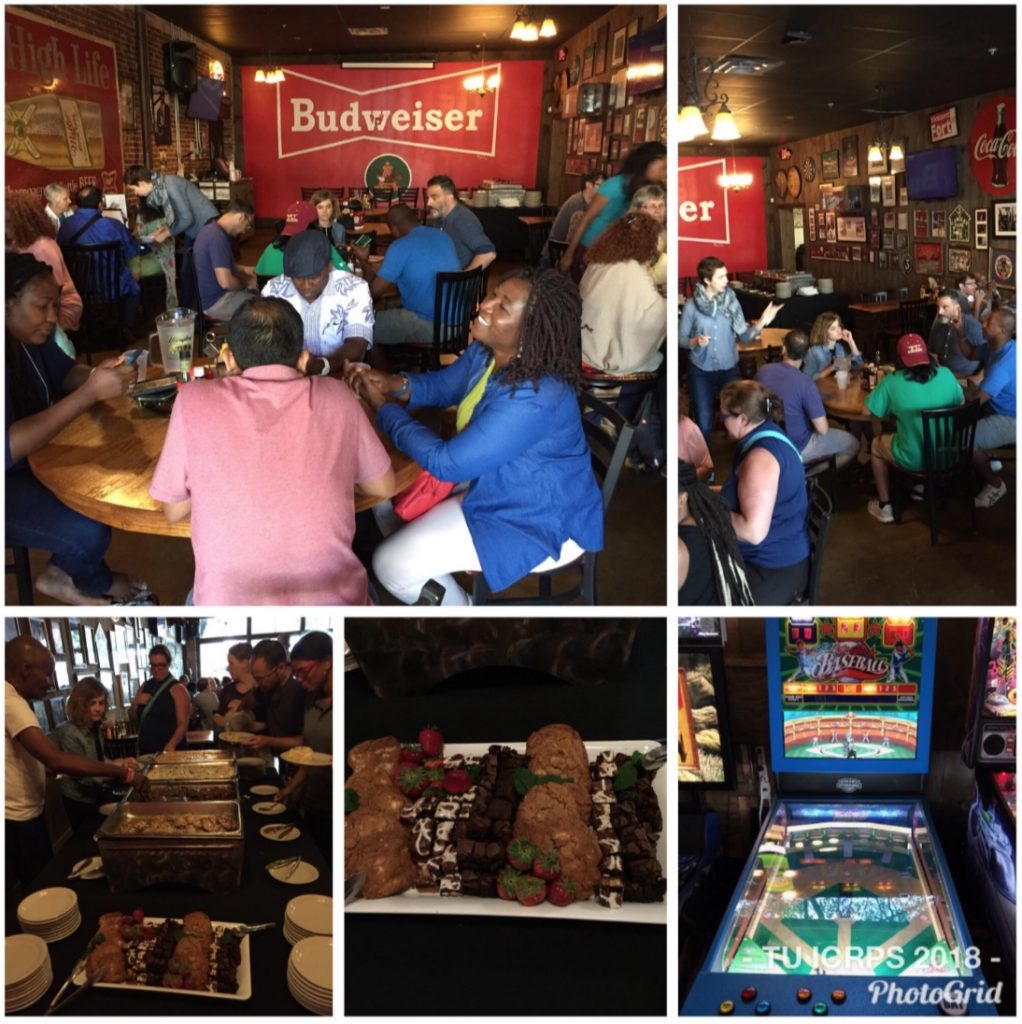
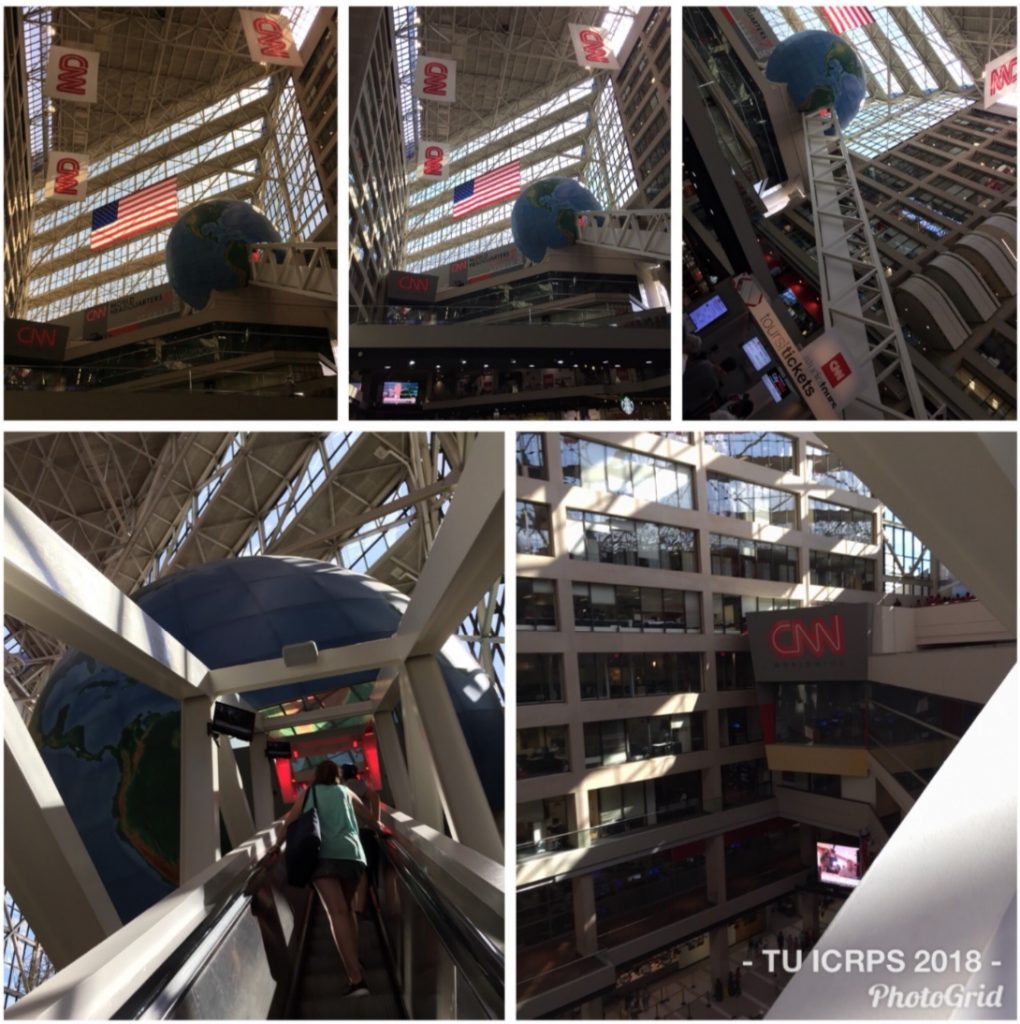
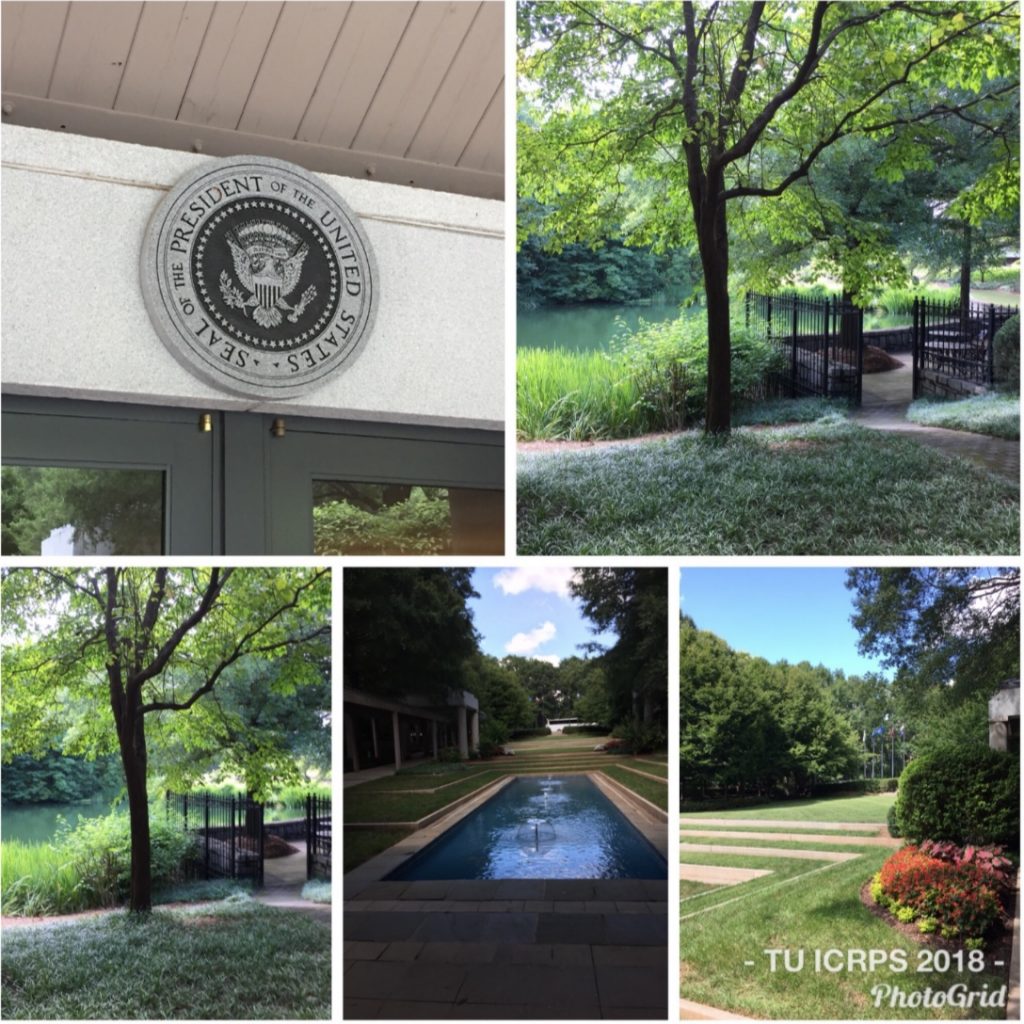
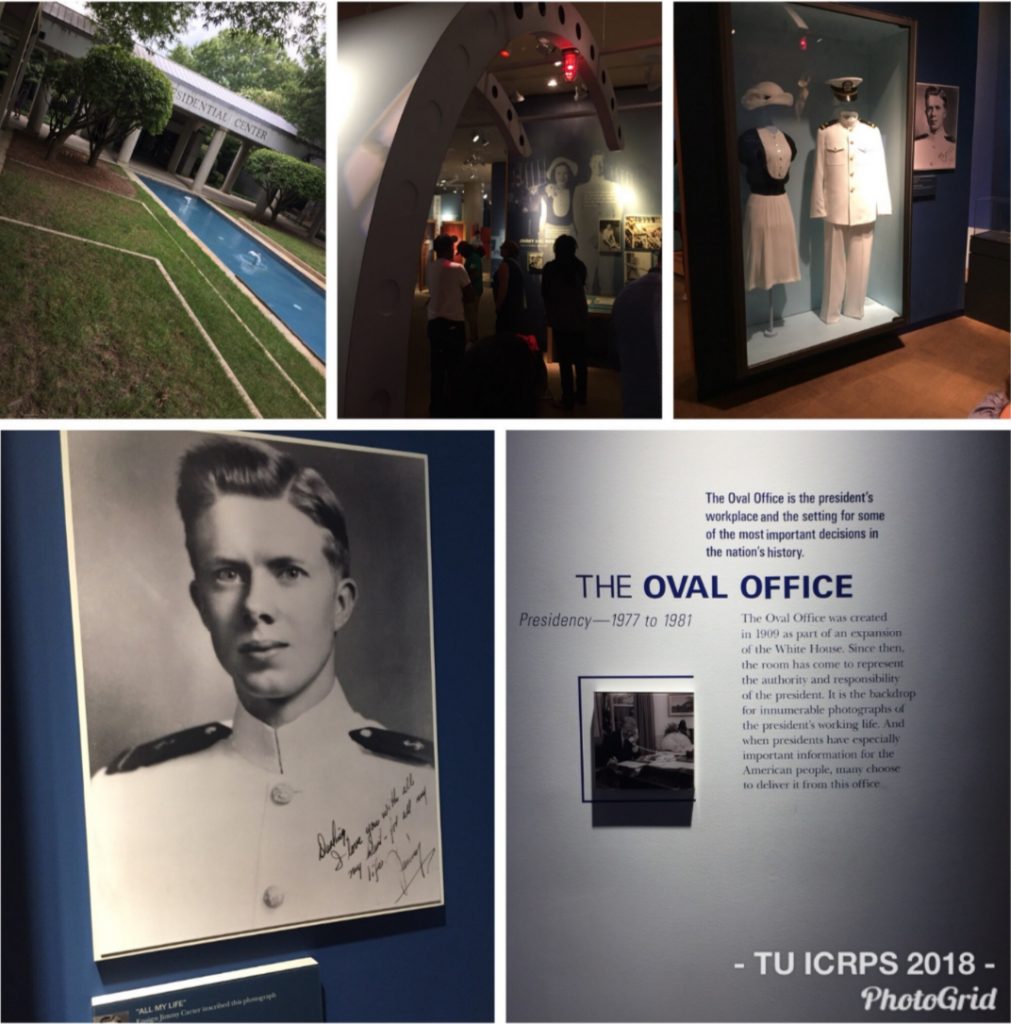
Day 6 – “Bombingham”
Written by: Miquel Correa (Autonomus University of Barcelona) & Jasmine Ratliff (Tuskegee University)
“To the privileged, equality is a sacrifice.” These are the words one of our wise tour guides, Barry, would like for us to reflect on today and every day. He would like for us to pass on the message to be mindful of your privileges and make sacrifices to spread justice for all.
When Birmingham’s Mayor Randall Woodfin’s Liason, Felicia Mitchell, gave us a warm welcome, she mentioned how the city has had many nicknames from “Magic City”, “Pittsburg of the South”, to “Bombingham” and then later the “Mecca of the South”. Rightfully, “Bombingham” was the one that stayed on the forefront of our minds throughout the trip.
16th Street Baptist Church – “The People’s Church”
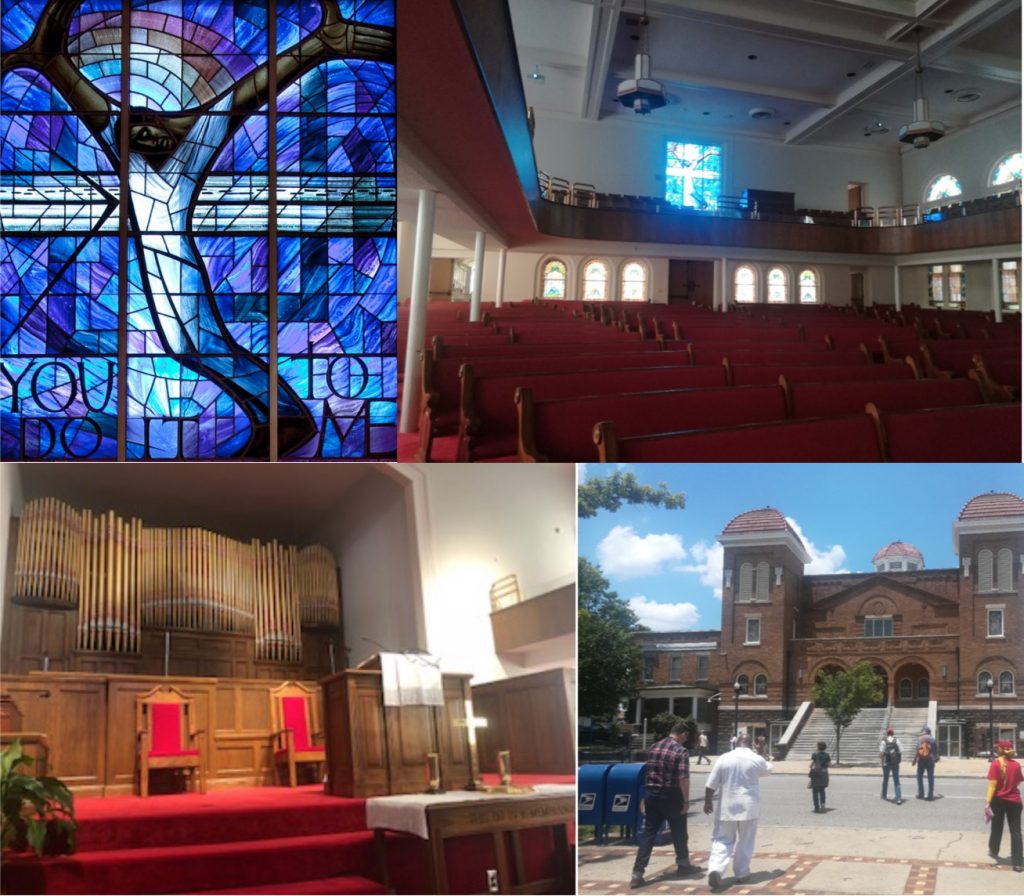
14-year-olds Addie Mae Collins, Denise McNair, Carole Robertson, and 11-year-old Cynthia Wesley, were killed on September 15, 1963 in the 16th Street Baptist Church bombing where Dr. Martin Luther King Jr. performed the eulogy. Dr. King also presented his “I Have a Dream” speech to the congregation here before unveiling it to the world at The Lincoln Memorial.
It was over a decade after the bombing that ring leader, Klu Klux Klansman, Robert “Dynamite Bob” Chambliss, was convicted of first degree murder. Despite FBI agents “losing” almost all of the physical evidence post-trial, in 2001 and 2002 respectively, Thomas Edwin Blanton, Jr. and Bobby Frank Cherry were convicted by then lead prosecutor, U.S. Attorney for Alabama’s Northern District, Doug Jones.
Today, not only did we visit a church that President Obama named a nationally historic landmark, but we visited a place that was used to plan strategies and demonstrations, it was the center of social change.
Speaking of change –
“I am of the firm belief that public servants can do great things for the people. There are too many politicians who let their egos get in the way and play to their bases. We need politicians who focus on the issues people care about.” –Senator Doug Jones
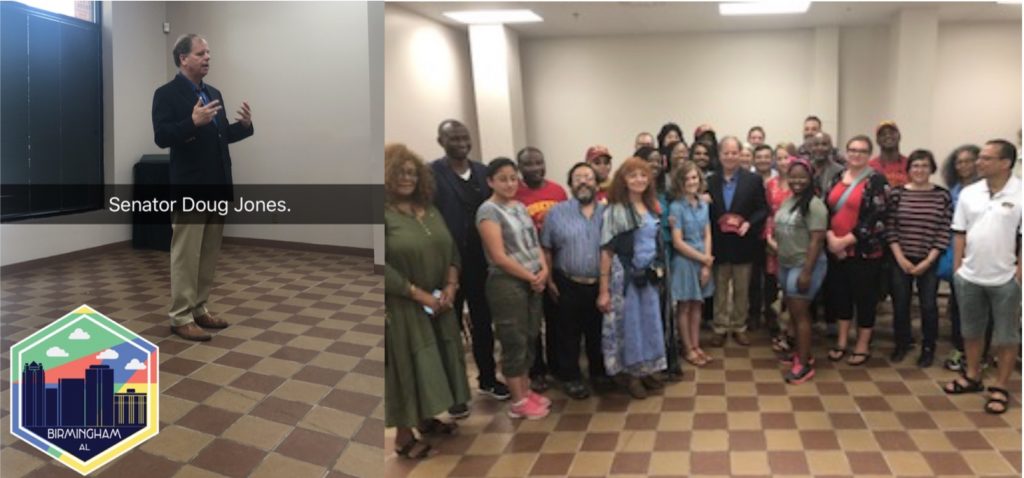
Meeting with Senator Doug Jones was both hopeful and helpful. Hopeful in a sense that Alabama is shifting in a way that will be beneficial to all of its residents, even rural. Helpful in a way of giving us face-to-face access with one of the legislative leaders who has the power to propose policy.
Senator Jones shared with us his personal connections to the four U.S. Senator Committees he has been appointed to and then his top three issues he’s currently working towards- expanding Medicaid, getting grants for much needed sewage infrastructure upgrades, and broadband expansion. We were then able to ask questions regarding his past time as an attorney and his current commitment to rural areas, more specifically Tuskegee and people placed development over the historically chosen place based development.
Birmingham Civil Rights Institute
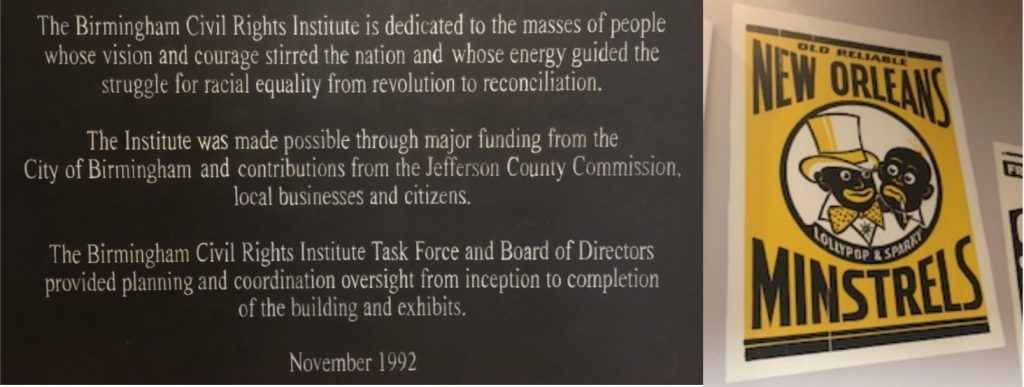

The entry way is deliberately lined with plants of rosemary used for amnesia treatment to jog the memory and hopefully engrain the lessons learned into the memory of the millions of visitors. The walkway of bricks leading to the entry tells the lyrics of songs “Jesus Loves the Little Children” & “We Shall Overcome” with red, yellow, black, and white bricks interlocked in intricate patterns. As we emotionally progressed through the Barriers, Movement, Confrontation, and Human Rights galleries, the stories of so many Civil Rights warriors were captured in our hearts.
Birmingham Fish Market

The afternoon in Birmingham concluded with a well-planned lunch at The Fish Market. As we boarded the bus “home”, Barry guided us on an unforgettable driving tour around the city. The stories that Barry told us, regarding the statue Vulcan, the “heaviest corner on Earth” or the soon-to-be-restored Gaston Motel, were extremely interesting. The tour took us back to 20th century-Birmingham, remarking its industrial past and the on-going fight for civil rights, which gives this southern city its sense of uniqueness. There could not have been a better end to our trip to Birmingham, and we are so grateful to Barry for his dedication to us during the whole day.
On our way back “home” to Tuskegee after two long and inspiring days, we still had time to stop at The Outlet Shops of Grand River, where some scholars would find nice bargains and others would opt for refreshments while recalling past ICRPS experiences.
We would like to leave you with the words that Dr. Martin Luther King Jr. said to the families of the four girls killed in the 16th Street Baptist Church Bombing. These words are so relevant currently, remembering the dark times of yesterday as we strive to ensure policies are inclusive and implemented with equality today.
“I like to believe that the negative extremes of Birmingham’s past will resolve into the positive and utopian extreme of her future; that the sins of a dark yesterday will be redeemed in the achievements of a bright tomorrow.” – Dr. Martin Luther King Jr.
Written by: Sherine Salmon & Dalal Alkordi
 How many bubbles do you think is in that bar of soap? How many jelly beans do you think is in the jar? These were the type of questions in the literacy test for African Americans when they tried to register to vote (intimidation). Day 5 of ICRPS focused on the historic sites of Selma and Epes. March 7, 1965 in Selma, Alabama, dubbed ‘Bloody Sunday’, saw the historical march along the Edmund Pettus Bridge that provided the right for blacks to vote. This march was motivated by their constant denial to partake in the ‘democratic’ system of the United States of America, along with the shooting and subsequent, death of Jimmie Lee Jackson. The walk across the bridge led us to the site, now called the Civil Rights Memorial Park, where police brutality was enacted upon the activists. ‘Someone marched for me’ were the lyrics that accompanied the tune that played throughout the visit at The National Voting Rights Museum. The museum sought to highlight the work of the foot soldiers – the unsung heroes who never counted their lives too important in light of the greater goal – whose unwavering stance proved successful. Their sacrifice could only be rewarded by the announcement of the 1965 Voting Rights Act, signed on August 6 of the said year. The visit to the Selma Interpretative Center, afforded us the opportunity to meet Mayor Darrio T. Melton, who gave us insight on the current projects of the town as well as the needs of the community. The visit to this center further highlighted key players in the movement towards equal rights to vote for African Americans. The joint efforts of the Courageous Eight (Mrs. Amelia Boynton, Mrs. Marie Foster, Mr. Ernest Doyle, Rev. John D. Hunter, Mr. James Gildersleeve, Rev. Henry Shannon, Mr. Ulysses Blackmon, and Dr. Frederick D. Reese) of the Dallas County Voters League (DCVL), the Southern Christian Leadership Conference (SCLC) and Student Nonviolent Coordinating Committee (SNCC) led to the evolution of social systems. We were then hosted for lunch at the Wallace Community College.
How many bubbles do you think is in that bar of soap? How many jelly beans do you think is in the jar? These were the type of questions in the literacy test for African Americans when they tried to register to vote (intimidation). Day 5 of ICRPS focused on the historic sites of Selma and Epes. March 7, 1965 in Selma, Alabama, dubbed ‘Bloody Sunday’, saw the historical march along the Edmund Pettus Bridge that provided the right for blacks to vote. This march was motivated by their constant denial to partake in the ‘democratic’ system of the United States of America, along with the shooting and subsequent, death of Jimmie Lee Jackson. The walk across the bridge led us to the site, now called the Civil Rights Memorial Park, where police brutality was enacted upon the activists. ‘Someone marched for me’ were the lyrics that accompanied the tune that played throughout the visit at The National Voting Rights Museum. The museum sought to highlight the work of the foot soldiers – the unsung heroes who never counted their lives too important in light of the greater goal – whose unwavering stance proved successful. Their sacrifice could only be rewarded by the announcement of the 1965 Voting Rights Act, signed on August 6 of the said year. The visit to the Selma Interpretative Center, afforded us the opportunity to meet Mayor Darrio T. Melton, who gave us insight on the current projects of the town as well as the needs of the community. The visit to this center further highlighted key players in the movement towards equal rights to vote for African Americans. The joint efforts of the Courageous Eight (Mrs. Amelia Boynton, Mrs. Marie Foster, Mr. Ernest Doyle, Rev. John D. Hunter, Mr. James Gildersleeve, Rev. Henry Shannon, Mr. Ulysses Blackmon, and Dr. Frederick D. Reese) of the Dallas County Voters League (DCVL), the Southern Christian Leadership Conference (SCLC) and Student Nonviolent Coordinating Committee (SNCC) led to the evolution of social systems. We were then hosted for lunch at the Wallace Community College.
Our trip had a very special stop after lunch at the Jackson House which held the spirit of Martin Luther King Jr. and his importance to the voting rights act; this is the place where he had meetings and spent his time while in the south. Each corner and room of this house had an interesting story. After the amazement with the Jackson house, we had the pleasure to visit the church where Dr. King worshipped and had some speeches, the Brown Chapel AME Church. It was established in 1908 and interestingly was built by black architects. This church played a vital role in the civil rights movement and nonviolence revolution, especially in the march of Bloody Sunday. Since 1960 people started gathering inside the church for these causes. In 1997, the church was named a historic landmark.
Despite the long day and the heat on our heads, we were so excited for our second trip to Epes, Alabama. Once we made it to the Federation of Southern Cooperatives Training Center, we were warmly welcomed by Marcus Bernard, the director, and his employees. We enjoyed wonderful food while learning about the different kinds of collaboration and assistance done by the Cooperatives with regard to land loss issues. The cooperative as a nonprofit organization addresses small black farmers’ business struggles. The cooperatives’ main principles are (land, labor, capital, and, management). The documentary viewed acknowledged that African American farmers are in need of more knowledge, technical assistance and how the cooperatives make decisions to help create new jobs. We also discussed and explored information on the socio economic conditions that depress almost all the Black Belt Counties. We felt proud at the end of the day when we learnt about the successful collaboration between Tuskegee University and the Federation (zero sum game).
Photo display of the ‘Bloody Sunday’ march; Selma Interpretative Center
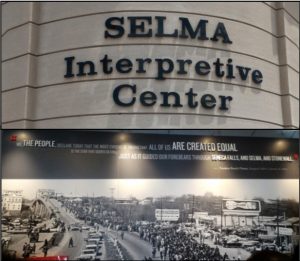
Foot molds of actual foot soldiers of the ‘Bloody Sunday’ march; The National Voting Rights Museum
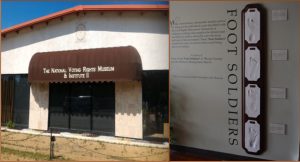
Monuments of 4 of the Courageous Eight along with the founders of the Civil Rights Memorial Park
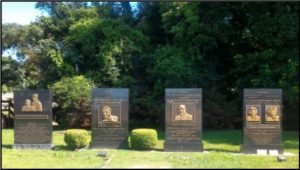
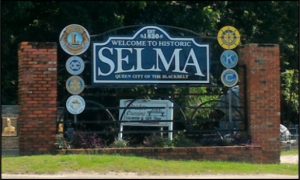
Edmund Pettus Bridge
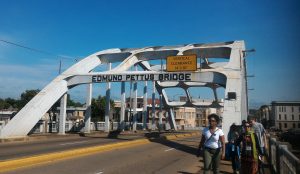
From Left: Dalal, Joanna Jackson, Sherine; The Jackson House
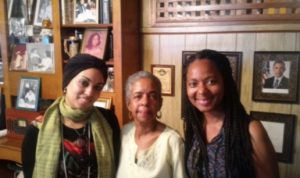
Written by: Folashade Adalumo Ntam, Lucy Asare-Baah, & Donna Davis
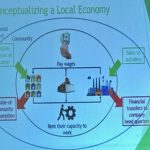
The morning session started with two presentations about Rural, Community and Economic Development and Strategic Planning. We were introduced to two developmental models, the people and place-based policy while focusing on rural areas in the South and how politics, history, social and economic dynamics of the South have impacted the region. Rural places make up less than 30% of the US hence these areas have had less benefit and less voice in shaping national policies compared to urban areas. From a historical economic perspective, agriculture has been the major driver with labor and skill offered cheaply by enslaved Africans and later shifting the African Americans into low cost, low skill labor manufacturing – thus successfully maintaining persistent poverty in the region since 1930. To help reduce this problem, government needs to create policies that are more people based in order to develop the individual by developing the skill set of rural America. Also, we were encouraged to take advantage of the global economy; produce locally and ship the goods across to the buyer and make a decent income.
While people-based policy focuses on residents that live there, place-base focuses on physical infrastructure and has historically been the policy adopted more in the US. With a top-down government structured approach, commissions such as the Appalachian, Denali, and Southeast Crescent lag behind where development based who and where decisions are made. The major cause of poverty comes from lack of adequate (effective) policy. Next, we discussed the topic of rural development and the numerous programs offered that are directed to individuals such as the homeownership and community facilities building. Programs in renewable energy systems, telecommunication, and broadband funding were also introduced. Noteworthy is the telemedicine grant which helps rural communities connect teacher, student and medical providers over distances. The rural development offices are in four regions (western region, north-central, northeast and southern) with 47 state offices and 400 area offices.
The part two of the strategic planning topic was a discussion of the type of development initiatives and programs. We looked into the enterprise zones and how these transitioned into opportunity zones. Next, we learnt that program participation Canada is highly impacted by distance and density which has influence on rurality. Accordingly, changes in the rural communities occurred with events that led to national building with rural as a resource bank; interventions with top down policies between 1950- 1980; reconstructing with neoliberalism and industrial flexibility between 1980 -2009; and lastly a negation period of winners and losers in post 2009. Local economic development and entrepreneurship relied on series of federal initiatives, hence the creation of jobs seizes as subsidies run out. Community futures Program (CFP) was needed at this time when LIP, LEAP and LEDA which depended on federal support had to be replaced with new strategy that is more community based with local priorities and community control. Thus, CFP started in 1985, private incorporated, not for profit organization and led by the community-based governance boards with key activities centered around business financing, business information and services, community strategic planning and CED projects and partnerships. There are 269 Community Futures in Canada in nearly all provinces and territories while targeting rural and northern communities. CFP has positively impacted these communities since information is available to the communities with respect to funds available for development and how funds are disbursed.
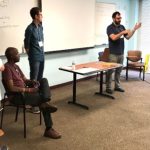
Then the third presenter took us across the ocean and there we saw that Europe has a large diversity rural development policy and is funded through the European agriculture fund for rural development with six priorities with fostering knowledge and innovation and promoting resources social inclusion as examples. It was implemented at local level by local communities to promote clear and transparent procedure. Also, cooperation, networking facilitating innovation and area based local development strategy are examples of features looked at with a bottom-up approach (unlike the US opportunity Zone which is a top-bottom approach with little or no community involvement in the decision making process).
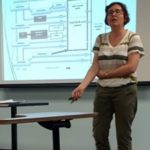
The afternoon session under the topic Agriculture Food Policies and Food Security, had two informative presentations. The first gave an enlightening video clip on food waste; definitions and differences between Loss (production) and Waste (throw away); and suggested some of the Loss/Waste potentials from production and harvest process through the consumption and restaurant phases. A high amount of food waste comes from the consumer – with a general lack of knowledge by the consumer and government food and safety regulation policies compounding the outcomes. Also of significance is the loss/waste of natural resources with unconsumed food including water, land use, the carbon footprint for fuel/pesticides/fertilizers, and operator money. This represents just the tip of the iceberg!
The next speaker presented the European Food Banks Federation (FEBA) program and it growing overall efforts to focus on food security while building capacity to adapt to new situations. While increasing operations and efforts in both the US and the UK, the FEBA is also continuing to focus on the importance to serve as co-operator; to continually improve fresh products; and to focus and continue to work with local social services for efficiency.
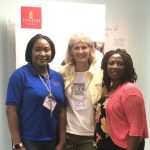
During the break Tuskegee students conducted ICRPS recording-clips and provided photo opportunities with some happy blog writers (as shown on the right).
ICRPS doesn’t only teach participants about book knowledge, they extend beyond that by providing hands-on demonstration of what is being taught in the classroom. After class we visited the Global Center for Post-harvest and Food Processing at Tuskegee University where ICRPS participants were engaged and exchanged information about the live and ongoing demonstrations and research. The TU post-harvest was established base on research within the US and Africa by faculty from the College of Agriculture to build TU’s long term capacity in post-harvest and food processing technology to help limited resource farmers in the Southeastern region of the US reduce farm loss. Food loss is more predominant in the developing world while food waste is more of a challenge in the developed countries from retail to consumption on the supply chain. The highest farm loss (46%) experienced by local farmers in the black belt is as a result of drought, but it is important for these farmers to understand cost benefit analysis if they have an idea of what their losses are and how best these farmers can add value to their left over farm produce.
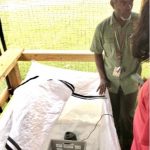
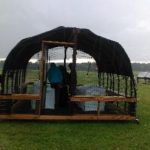

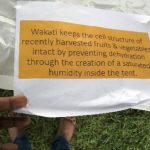
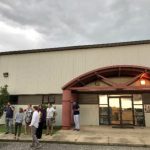
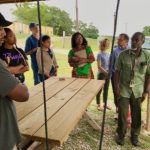
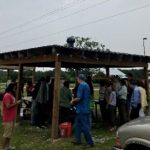
A little ‘hoops’ to finish the day by our energetic 2018 classmates!
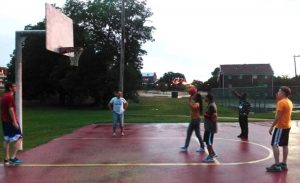
(Picture by Ana Paola)
Written by: Riikka Kangas, Jabeka Macklin, & Sandra Moore.
We started the day boarding a bus at the Kellogg Center at Tuskegee University and picking up a few local students at a gas station along the way. Once all of us were on board the bus we headed down Interstate 85 for a 45-minute drive to Montgomery.
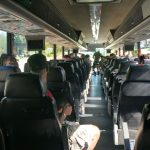
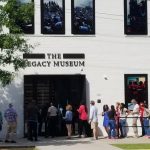
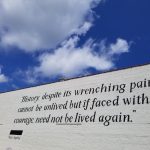
Our first stop was the Equal Justice Initiative Legacy Museum. This legacy museum opened in 2018 and shows the history of the injustice towards African Americans in the United States. From displays in the center we learned many astonishing facts such as that between 1820 to 1860 the population of slaves in Alabama rose from 41,879 to 435,080, that Alabama banned the presence of “free blacks” during slavery times, and after emancipation in 1863 there were still strong proponents of slavery such as Mississippi’s Governor who stated that “they (African Americans) are to be returned to a condition of serfdom. An era of second slavery”.
Many of us stated this was an emotional visit. Many felt that it was unbelievable that humans could treat other humans that way, or how it was possible that so many people could have committed these atrocities and how so many people could have followed such immoral thoughts. Many others also thought it was overwhelming to see things you already knew in such an honest, authentic manner, for example in the entrance hallway of the museum there was the portrayal of an auction block with holograms of slaves in holding cells before they were sold.
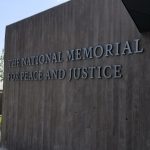
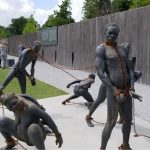
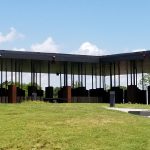
Our next stop was the National Memorial for Peace and Justice, a six-acre site overlooking Montgomery that is a memorial for the more than 4,400 African American men, women, and children who were killed by the terrorist act of lynching between 1877 and 1950.
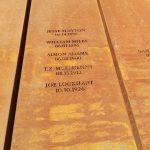
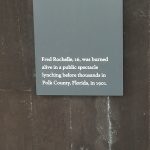
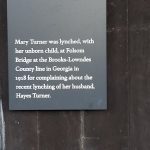
As you enter the site, you walk up an elevated path to the top of a hill where there are 800 steel monuments from each county where the lynching’s occurred throughout the United States. Each box was inscribed with the names (if known) and dates of the individuals who died. There was also a section describing why some of these people were lynched. The names of those known and unknown were verified by at least two written documents. Again, an emotional site to visit for the group.

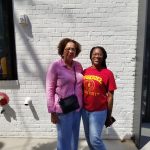
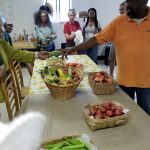
Boarding the bus again we headed back toward Tuskegee to visit the Al Hooks farm, a small processing farm, led by Demetrius Hooks and his dad Al Hooks. The farm processes and supplies various produce to local grocery stores and farmer’s markets.
Back on campus, we debriefed as a group on the day’s visits. One of the local participants, Kara, told us how our past connects to our present – she was able to confirm her own family history when she saw four of her relatives names at the Equal Justice Legacy Museum on the Community Remembrance Project Exhibit.
The final session of the day was Disparities, Race, and Social Justice. We had two presentations from faculty – Philomena De Lima led a discussion on intersecting identities, rurality and implications for rural policy and Wayne Kelly discussed community resilience and youth engagement. We concluded with an activity that made us realize that despite our differences we have many commonalities.
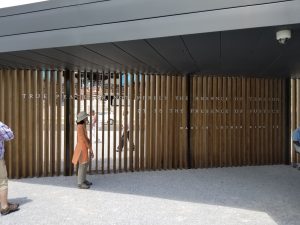
By Kara Woods and Emily Piontek
We started the second day of the conference by learning about different research methods. Going from general to specific, we discussed the universal linguistic relationships found in classifying natural observations within ethnoscience: taxonomy, patronomy, and queuing. After, more specific research methods were taught during breakout sessions. Sessions about Quasi Experimental Dialogue, Community Based Organizations, Data Sets and Key Informant Interviews introduced both qualitative and quantitative methods which help organize as well as analyze data. An important takeaway from the morning session was how much your specific research question directs the method used, questions asked, and informants interviewed. Another takeaway is the importance of united understanding when asking questions for research. During the session Robert Zabawa gave the example of finding farmers in West Africa that cultivated orange- fleshed sweet potatoes. Even though many farmers asserted they grew orange-fleshed sweet potatoes, none were found during farm visits. The conclusion was the different understanding of what the color orange entailed. When researching, common understanding and classification between researchers and research participants is imperative.
After lunch, ICRPS students and faculty members reconvened for an afternoon focused on the history of Tuskegee University itself, as well as the contextual history of racial injustice and inequality in the United States. Walter Hill of Tuskegee University presented on the history of land grant institutions such as Historically Black Colleges and Universities (HBCUs), and discussed the importance of continued advocacy for policies and funding that fairly support HBCUs. Jerry Pennick of the Federation of Southern Cooperatives presented on his work in developing relationships between community organizations and Tuskegee University. The Integrated Research & Extension program, which he administers, works to empower and support marginalized communities by connecting rural citizens to both resources and researchers at the university. Finally, Tuskegee archivist Dana Chandler discussed the impact made on Tuskegee University, and the scientific community at large, by George Washington Carver and his agricultural discoveries. Notably, Carver understood that “green agriculture”, or the use of agricultural products and processes to serve as energy sources, would one day supplant American dependence on oil.
ICRPS finished the afternoon with our first field trip away from campus. We rode through lush, verdant Alabama for a tour of the Tuskegee Airmen National Historic Site. The Tuskegee Airmen were the first African American members of the US Air Force, who overcame significant discrimination to become some of the finest fighter pilots of WWII. Their service paved the way for desegregation of the United States military. Our final stop was a visit to the Tuskegee Human and Civil Rights Multicultural Center. This museum portrays the US Public Health Service Study of Untreated Syphilis in the Male Negro, as well as the history of racial injustice in the United States. The US Public Health Service Study of Untreated Syphilis in the Male Negro, conducted between 1932-1972, was a federally sanctioned study in which hundreds of African American citizens were diagnosed with syphilis, yet left unaware of their condition. These men, never treated for the disease, were left to live untreated for the duration of their lives, even after a treatment for syphilis had been discovered. The presentations and field trip of the afternoon showed how far the United States has come in overcoming racial injustice, while emphasizing how much policy, development, and social justice work is left to be done.



